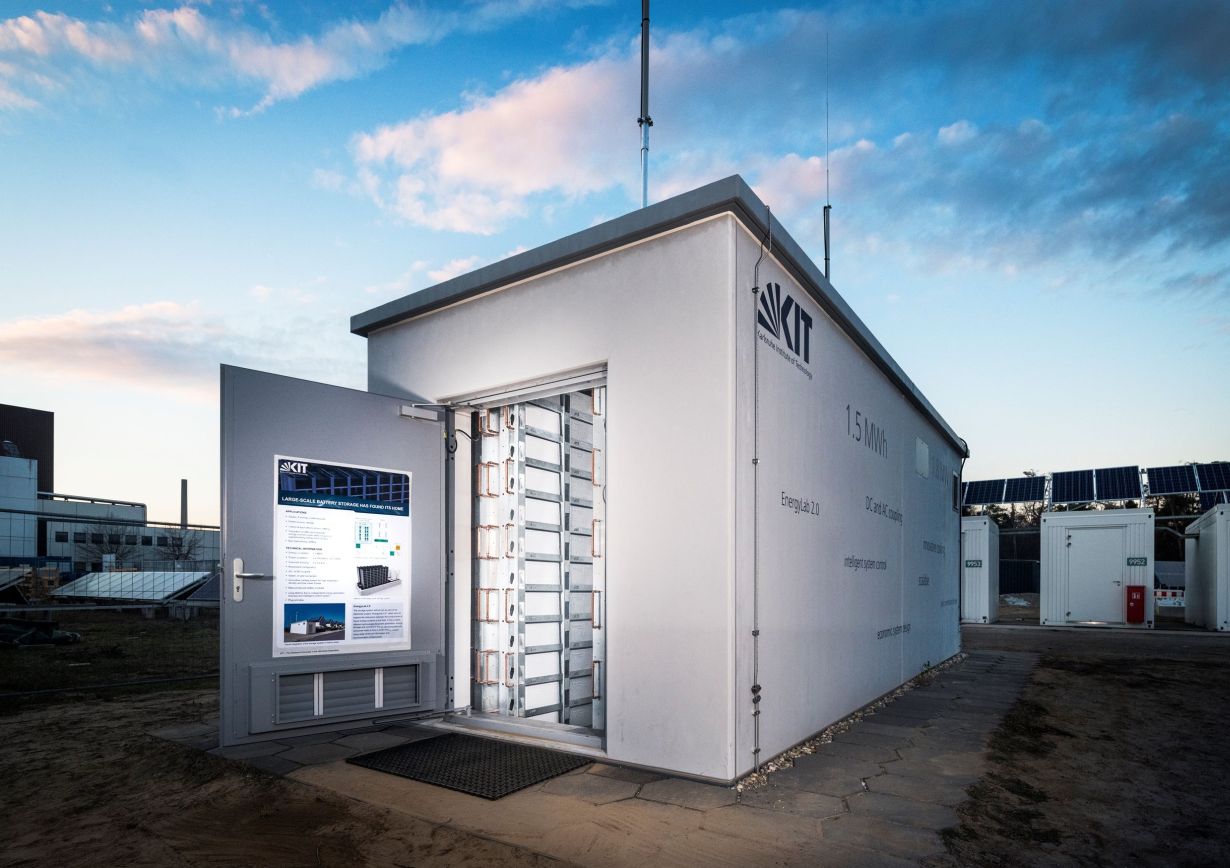Two close-to-production mass storage facilities are now complementing the Energy Lab 2.0 of Karlsruhe Institute of Technology (KIT). The scientists are testing optimized control by a new lithium-ion storage system for short-term grid stabilization and a new redox-flow storage system for longer storage terms.
In case of an increasingly decentralized and fluctuating energy production from renewable sources, building of storage capacities for grid stabilization is a central challenge. With the close-to-production prototypes of two energy storage systems, including an optimized control system, KIT is now demonstrating two standard solutions. Within its Energy Lab 2.0, a large-scale energy research infrastructure at KIT, a new lithium-ion storage system and a new redox-flow storage system have been taken into operation. “We will demonstrate the interaction of the new energy storage systems with other grid components in close-to-practice operation,” says Professor Roland Dittmeyer, scientific coordinator of the Energy Lab 2.0. “Our development work is aiming for low-cost, but efficient mass storage facilities for the future energy system.”
Dynamic: Lithium-ion Battery Storage System in the Energy Lab 2.0
Lithium-ion storage systems are particularly suited for short-term dynamic power supply. Already now, they significantly contribute to grid stability. However, battery storage systems based on lithium-ion technology are associated with high costs. Apart from investment costs, also operation costs play an important role. With the new lithium-ion mass storage system of the Energy Lab 2.0, KIT has implemented a solution with very low operation and maintenance costs.
The new storage system supplies a total of 1.5 MWh usable energy at up to 800 kW electric power. “Thanks to the novel system structure, costs are reduced considerably,” says Project Head Michael Mast from the Battery Technical Center of KIT, where the energy storage system was developed. “In particular, we have optimized cooling and enhanced the efficiency of the energy management system. Based on a detailed characterization of the lithium-ion cells used, we can operate the batteries gently, which increases their service life and further reduces total costs.” Apart from cooling water from ground probes, also the concrete shell is used for passive cooling. By partial lowering into the ground, the space needed for the battery storage system is minimized. Development focused on efficiency as well as on the safety of the lithium-ion storage system. An attractive design and low noise emission enhance acceptance as district storage systems in residential areas.
Scalable: Redox-flow Battery Storage System in the Energy Lab 2.0
Apart from frequency stabilization, the future energy system will also need solutions for medium- and longer-term energy storage, e.g. for using solar energy during the night or for the intermediate storage of excessive wind energy until use on days without wind. Redox-flow batteries are suited for these purposes. They store the electric energy in liquid chemical compounds mostly based on vanadium oxides. While lithium-ion storage systems can supply balancing energy within fractions of a second, redox-flow storage systems are less dynamic, as mechanical pumping systems are applied. When used properly, however, redox-flow storage systems have major advantages. Storage capacity and power can be scaled nearly randomly and independently of each other. Moreover, the redox-flow battery is unburnable.
In the Energy Lab 2.0, a vanadium redox-flow battery storage system of 0.8 MWh energy and 200 kW power was installed. Through higher-level control, it can be combined with the lithium-ion storage system to a hybrid storage system. Work is aimed at finding a solution that combines the advantages of both technologies. Another reason for researchers to further develop the interaction of both storage technologies is the use of various resources when producing the storage media. In this way, supply bottlenecks can be prevented.
More about the KIT Energy Center: http://www.energy.kit.edu
Being “The University in the Helmholtz Association”, KIT creates and imparts knowledge for the society and the environment. It is the objective to make significant contributions to the global challenges in the fields of energy, mobility, and information. For this, about 10,000 employees cooperate in a broad range of disciplines in natural sciences, engineering sciences, economics, and the humanities and social sciences. KIT prepares its 22,800 students for responsible tasks in society, industry, and science by offering research-based study programs. Innovation efforts at KIT build a bridge between important scientific findings and their application for the benefit of society, economic prosperity, and the preservation of our natural basis of life. KIT is one of the German universities of excellence.

